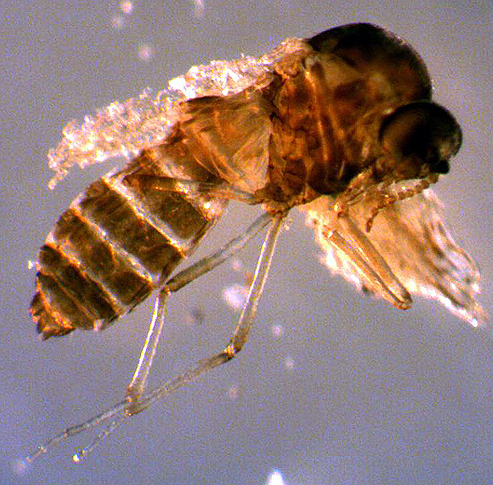 |
| The fly Dasyhelea, preserved in three dimension in the Barstow Formation Farrall Smith |
Formation: Barstow Formation
Age: Miocene (16-13 Ma)
The Mid-Miocene Climatic Optimum falls in the midst of a subdivision of the Miocene known in North America as the Barstovian Land Mammal Age, named for Barstow, California. While the city is famous today as the midpoint between Los Angeles and Las Vegas and for being the very worst the Golden State has to offer, it has considerable fame among paleontologists. This is primarily due to its mammal fauna, represented both by skeletal material and, more unusually, by trackways. As productive as the mammal-bearing units of the Barstow Formation are, though, it is the remains of insects that qualify certain units as lagerstätten. We've seen a few localities with well-preserved insects, but in most cases (Riverlseigh being the one big exception), these are preserved as flattened remains or as trace fossils (chewed leaves, social insect nests, and the like). At Barstow, the exoskeletons of insects and other arthropods were replaced by silica-rich minerals, strengthening them and allowing animals to be preserved in three dimensions. The most abundant of these fossils are adults and larvae of salt-tolerant insects (especially beetles and flies) and fairy shrimp, which are neither insects nor shrimp, but crustaceans that specialize in living in ephemeral desert ponds. The species preserved in the Barstow insect beds show that, while Nebraska may have been covered in grasslands and Idaho was home to deciduous forests in the mid-Miocene, southern California was a much drier place (not a huge surprise, given Barstow's modern location in the midst of the Mojave Desert). More than that, the composition of the arthropod fauna changes between beds, showing that the landscape got ever more arid as time passed. This likely was driven local climatic changes related to the uplift of the land and the shallowing of the lake in which the fossils were preserved, but also reflects a global trend. While we tend to think of climate change solely in terms of temperature, other variables fluctuate through time as well. As the MMCO ended and temperatures began their slow, steady decline, most areas of the world also saw less precipitation. This increase in aridity is very nicely illustrated by the Barstow arthropods and would, among other things, play a major role in the increased global spread of grasslands and animals adapted to a life on the open range.
Visit: The Barstow insect localities are located on BLM land, but there are no visitor facilities associated with them that I'm aware of.
Fossils: Barstow mammal fossils stars of the show at many Southern California museums, such as the LA County Museum, the Raymond Alf Museum, and the San Bernardino County Museum. To the best of my knowledge, the insect fossils are not exhibited anywhere.
Is there a relevant book full of gorgeous fossil photos that I can gift to a paleontologically-minded friend?: Nope.
This post is part of my 2015 Paleontology Advent Calendar, a series of vignettes on lagerstätten - sites of exceptional fossil preservation - that document changes in climate and environments through the Cenozoic. You can see the other posts here.
No comments:
Post a Comment